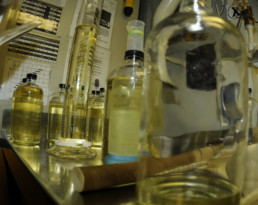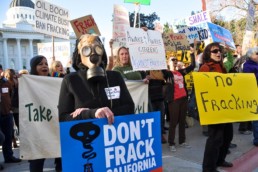Advanced Biofuels Cushioned Against Oil’s Crash
By Brentan Alexander, PhD; Chief Science Officer & Chief Commercial Officer
Oil prices are cratering to levels unimaginable just months ago and major ethanol producers are idling their plants. Although this is bad news for all types of fuels, renewable and fossil alike, there is a silver lining for advanced biofuels. These sources qualify for a broad set of renewable credits, diversifying their revenue streams and providing a layer of protection against the price destruction occurring in the fuels marketplace.
What’s an advanced biofuel? It’s a fuel produced using wastes or agricultural byproducts, such as the corn stalk instead of the kernel. (The kernel produces traditional ethanol, which directly competes with food-crops for land and farmer attention.) Potential feedstocks for advanced biofuel projects include household trash (known as ‘municipal solid waste’), leftover woody biomass material after logging operations (known as ‘slash’), and the shells from almond orchards.
These feedstocks are currently either landfilled, plowed under, or (depending on local regulations and the desire to follow them) burned. But in the United States, their use in biofuels production is incentivized through a variety of state and federal credit programs. The federal system, known as the Renewable Fuel Standard (RFS), primarily supports the entire domestic ethanol industry with ethanol-blend targets for the nation’s fuel supply. Less known is that the program also supports more advanced biofuels development. The RFS authors envisioned that corn-based ethanol would be a temporary bridge to an advanced biofuels future, and created multiple credits, known as Renewable Identification Numbers (RINs), to differentiate between the various feedstocks used to produce a biofuel. These RINs trade on open markets and their prices fluctuate based on the demand from ‘obligated parties’ (those required to buy RINs to demonstrate compliance with the statutory requirement).
One type of RIN is targeted at cellulosic fuels: the ‘D3’. This RIN has unique characteristics that make it more valuable that other RINs under the RFS. It is essentially a wild card: the RFS is a ‘nested’ compliance structure and the D3 RIN also counts as a ‘D5’ or ‘D6’. As a result, in times of oversupply, D3 prices are shielded from falling below the prices of these other RINs. Another unique feature of the D3 is the cellulosic waiver credit (CWC). The value of the CWC is set by the EPA annually, based on the price of gasoline in the Unites States. As gasoline prices fall, the value of the CWC goes up (albeit on a time-lag). In times of undersupply in the D3 market (not true at the moment), this built-in hedge means advanced biofuels projects are protected from oil price drops.
###
Coronavirus Won’t Change Minds on Climate Change
In the absence of forceful government action, activists must stay on the front line.
By Brentan Alexander, PhD; Chief Science Officer & Chief Commercial Officer
As the global population is ravaged by the novel coronavirus sweeping across countries and continents, those searching for a silver lining have begun to suggest that the painful lessons of the current COVID-19 crisis may help change hearts and minds in the fight to curb climate change. The argument goes like this: If the parallels between the coronavirus crisis and the climate crisis can be properly explained to populations and their leaders, they will collectively see the need for action.
While I hate to add pessimism to an already trying time, I don’t count on that happening. The global response to the climate crisis, so woefully inadequate to address the scale of the problem, is not driven by a lack of understanding of the risks and realities of climate change. Even under the Trump administration, NASA’s climate change website touts the consensus of 97% of scientists that human-caused climate change is real. A full two-thirds of the American public believe the federal government is doing too little to combat the climate crisis. Leaders already know the threat we face, but largely fail to act anyways.
Instead, one enduring lesson of COVID-19 is how, in the face of near universal scientific opinion, political leaders routinely ignore expert advice and choose a path of maximum risk until significant damage has been done. Whether driven by advice from false authorities, fears of upsetting the status quo, or outright denial of the severity of the crisis, leaders around the world have repeatedly underplayed this crisis and failed to take definitive action to stem the onslaught. Even days ago, over 30 million people in the United States were free to congregate and actively continued the spread of the infection, even as deaths from the virus skyrocketed and hospitals in hard-hit areas set up tents to care for the patient surge. Faced with clear and imminent damage to communities and economies, some leaders still fail to act.
Others, however, do act: COVID-19 again demonstrated that action to stem a crisis can come from surprising sources. On the west coast of the United States, tech companies readily understood the science and implemented large-scale work-from-home policies a week or more before local governments followed (nevertheless as relative early adopters). As Washington D.C. argued about the severity of the crisis, the National Basketball Association, of all entities, showed true leadership by suspending its season, sparking a mass cancellation of high-density events from concerts to conferences.
This pattern is familiar to those on the front lines of the climate fight. In recent years, significant progress has been made in the private sector by focusing on so-called ESG (environmental, social, and governance) policies at major corporations. Major insurance providers and financiers now refuse to work with the coal industry, major private equity groups are backing off fossil fuel investments, and Microsoft is leading its industry by pledging significant carbon mitigation programs for its businesses. Progress is made in the absence of forceful government action.
With politicians now talking about further stimulus to recharge economies damaged by the COVID-19 pandemic, those fighting for the climate should stay in the fray and continue to work to secure programs and funding for a greener future. But absent an immediate, direct, relatable threat to our health and our economy, nobody should assume a sudden change-of-heart among the climate change deniers in Congress and the White House. On the climate front at least, it’s still business as usual: Politicians won’t be saving us; rather it’s our collective action that will bridge us to the future.
###
Troubles in the Fracking Industry Are Nothing to Celebrate
For those fighting climate change, the damage that American frackers are experiencing should be sobering.
By Brentan Alexander, PhD; Chief Science Officer & Chief Commercial Officer
With oil prices plunging from over $60/bbl to $30/bbl and lower in a matter of weeks, mid-sized American oil producers reliant on fracking have been identified as likely casualties from the sudden upheaval. The prospect of failures in the space is causing celebration among those opposed to fracking, with some trumpeting the end of an environmentally damaging process. The excitement is misguided: the failure of fracking companies in the current environment will portend increased difficulty stemming the climate crisis.
Hydraulic fracturing, or ‘fracking,’ is an oil and gas extraction technique that came in to heavy use in the United States around 2007. The process involves drilling long, horizontal wells deep underground in shale deposits, and then pumping high pressure water and chemicals to fracture the rock, increase permeability, and extract valuable hydrocarbons. Fracking was the key driver in pushing the U.S. to again become the largest oil producing country in the world over the last decade.
The technique has also been assailed as environmentally destructive. Poor control at some locations has been blamed for allowing drilling fluids to contaminate local water supplies. Earthquakes in Oklahoma dramatically increased after fracking became widespread. And leakage from fracking wells has been identified as a likely source of the increase in the atmosphere of the potent greenhouse gas methane since 2008.
But despite the environmental costs of fracking, the current situation is not one to celebrate. The underlying driver leading to pain at fracking companies is cheap fossil fuels, which will lead to more use of climate-driving fossil fuels and undermine efforts to decarbonize large swaths of the global economy. Saudi Arabia is now looking to pump over 12 million barrels of oil a day in April, an increase of 20% over January. Although global demand is currently constrained with the COVID-19 pandemic, cheap oil will surely lead to a rebound in demand and undercut competing alternatives, including biofuels and electric vehicles.
The situation is shedding light on a long-known truth in the energy world: prices are not driven by an efficient market based on supply and demand. Instead, the Saudis have longed dictated global prices, artificially limiting supply to hold a higher price. With a reported production cost of $2.80/bbl, the Saudis make considerable profit by constraining production. But as the last few weeks show, the Saudis also have the power to dramatically undercut competitors with little to no warning.
For those fighting climate change, the damage that American frackers are experiencing should be sobering: Saudi Arabia’s ability to suddenly flood the global market with cheap oil and undermine market-based efforts to supplant fossil fuels is an existential risk. If American frackers can’t compete with Saudi oil in an open market, greener alternatives surely won’t either.
###
Renewables Poised to Clean Up from Oil’s Price Spill
The oil market has changed dramatically in the last three weeks but renewables are financial safe bets
By Brentan Alexander, PhD; Chief Science Officer & Chief Commercial Officer
Saudi Arabia abruptly altered its oil production strategy in early March and began to flood the market with cheap oil. Financial markets worldwide hemorrhaged value at the prospect of a protracted and painful price war, and American oil firms immediately cut back spending and dividend payments as the price for their primary product halved. As of last week, WTI Crude (a pricing benchmark tied to US supply) was barely north of $20/bbl, prices not seen since 2002.
This sudden tumult represents an opportunity for the renewable energy sector. At first glance, this may sound counterintuitive. After all, oil prices seem largely unrelated to the prospects of wind, solar, and other renewables in the electricity generation sector, because in the United States the primary fossil source of electricity is natural gas. Natural gas prices have been largely uncorrelated with the price of oil since 2007, when large-scale domestic shale-gas production began to come online (see chart). In other parts of the world, coal drives electricity generation, which is similarly decoupled. Virtually nobody uses oil as a primary electricity source, except in certain very specific locations, such as Hawaii, where the demands of unique geography and supply logistics align to make oil the best bet for power production.
Data from US Energy Information Administration (EIA.gov)
Oil’s link to renewables instead comes through competition in the financing marketplace. As new projects are developed and financing is sought, the infrastructure funds that provide capital to enable these developments naturally prefer projects that promise the most attractive financial returns. With relatively high prices over the last decade and unmatched value as a transportation fuel, oil exploration has beaten out renewable project development on the financial metrics time after time.
The oil shocks over the last weeks could dramatically alter that calculus. Revenues for potential oil projects have suddenly dropped by over 50%, and futures contracts currently show only a modest improvement in prices by year’s end. The market is already pricing in the expectation that oil prices remain below $40/bbl for the foreseeable future, a dramatic change from the $55+/bbl that has been the norm for the last few years.
Even if prices do recover, the sudden volatility will still weigh on the minds of project investors. Oil markets haven’t resembled a purely competitive market since the mid 1960s, and since that time, prices have been regularly impacted by sudden and unforeseen changes in supply by OPEC producers, primarily Saudi Arabia. The rise in shale-oil in the US in the last decade has effectively put a cap on prices and provided a counterweight to OPEC’s pricing power. But the muscle being flexed now shows that the OPEC nations and Russia still maintain substantial influence over the fate of American oil producers. This ‘stroke of the pen’ risk, now that it has again bared its head, may be unlikely to be forgotten in the near future.
Renewables, by contrast, have no supply risk whatsoever, and are primarily exposed to fluctuations in the price of electricity. Insomuch as this relates to the price of natural gas, investors in the US will take comfort knowing gas is essentially a local market, with US prices driven by supply and demand within North America; there is little ability to arbitrage against global markets due to limited export capacity. Therefore, as oil prices come down, project financiers should start to turn more of their attention to the new safe bets that offer more durable returns: wind, solar, and the like.
This isn’t to say that renewables don’t face headwinds in the current environment. Cheap oil also competes with renewables in the transportation sector. Electric Vehicles will be less competitive with their gasoline-powered cousins as the price for gasoline at the pump drops, lowering demand for new grid capacity and forcing renewables to wait for retirements of current assets. The price for natural gas in the US is dropping as well, driven primarily by the sudden decrease in demand due to the shuttering of entire industries. These drops make fossil power from natural gas more competitive with their renewable counterparts.
Futures markets, however, are currently pricing in a full rebound of natural gas prices by year’s end, with the futures contract for Henry Hub for December 2020 currently priced above market levels at the end of 2019. This suggests that the drop in prices of natural gas will be temporary, and investors making long-term bets do not view the current situation as durable. Further, natural gas prices are just one component of the price paid by utilities to power producers, and so a drop in natural gas prices doesn’t necessarily imply a similar fall in the rates negotiated in new power purchase agreements. So the drop in natural gas prices evident in the market now looks to be temporary, and unlikely to dramatically alter the widespread conclusion that renewables are now the cheapest power source to build.
Altogether, the oil market has changed dramatically in the last weeks, in ways unforseen just a few short months ago. But despite the headlines and worrying drops across financial markets, opportunity lies in these disruptions. Renewables are well positioned to capitalize.
###
Farm or Fossil: The Battle for the RFS Rages On
There is a war being waged between farmers and oilmen impacting everything from the price of corn to the price you pay for gas at the pump.
By Brentan Alexander, PhD, Chief Science Officer & Chief Commercial Officer
For those of us following biofuels, there was an interesting bit of news last week that barely registered in the press outside of Houston and Des Moines: A U.S. Court of Appeals in Denver handed down a ruling forcing the U.S. Environmental Protection Agency (EPA) to re-examine three small-refinery exemptions granted for the 2016 compliance year within the Renewable Fuel Standard (RFS) regulation. You’d be forgiven for thinking that this ruling impacts something esoteric with limited impact on your daily life. Few Americans know about the RFS at the heart of this court battle, but there is a war being waged over this law between farmers and oilmen. It’s an intraparty slugfest pitting longtime allies against each other and impacting everything from the price of corn to the price you pay for gas at the pump.
Some background: The RFS was adopted in the mid 2000s, with the price of oil spiking and unrest in the Middle East causing concerns at home about domestic energy security. The name of the legislation enshrining the standard in law, the Energy Independence and Security Act of 2007, left little doubt to the motivations behind the policy: The law was written to jumpstart domestic biofuels production to help lessen America’s addiction on foreign oil. Signed by an oil state Republican, the law passed with just eight ‘no’ votes in the Senate. Republicans and Democrats alike cheered as this comprehensive program to support renewable biofuels became the law of the land.
U.S. farmers, primarily in midwestern states with a history of voting red, cheered as well. The program set mandates for the production of multiple biofuels, but primarily focused on ethanol and biodiesel, which are made from corn. Although more expensive per unit of energy than their fossil brethren, these fuels were literally home-grown, and the RFS supported their use by mandating blend volumes of biofuels in the U.S. fuel supply. With this mandate to refiners in place, corn prices surged, investments flowed to midwestern states, and an entire economy built around ethanol production was born. U.S. ethanol production rose from 1.63 billion gallons in 2000 to 13.5 billion gallons in 2010 and continued to grow from there as the U.S. Department of Energy (DOE) increased the blending mandate every year through 2018.
The program, however, was disliked by the oil companies, as it required building the infrastructure necessary to incorporate this new feedstock into their products. This new feedstock was also generally more expensive, raising prices for downstream consumers. To help lessen the blow, the RFS included some carvouts for the oil and gas industry. In particular, small refiners, concerned about their ability to afford necessary plant upgrades to compete with larger competitors under the mandate, were provided a pathway to secure waivers to the mandate. As drafted, the legislation required the DOE to account for the volumes lost from these waivers when setting annual targets, effectively shifting the obligations from the little guys to the big guys. Few waivers were granted, and large oil and gas companies, despite continued lobbying against the program, generally fell in line and followed the program requirements.
And then came President Trump. Unaware of the delicate politics involved, the Trump Administration immediately upon arrival began undermining the program. The number of waivers granted skyrocketed from under 10 to over 30 in two years. Large refineries, never intended to be excluded from the program, were given waivers as well. And the DOE, when setting its mandates, ignored the missing gallons, effectively reducing demand for biofuels by billions of gallons with the stroke of a pen.
The Trump Administration is generally unconcerned about public blowback to its various deregulation activities, but in this case their actions didn’t just #OwnTheLibs, they triggered midwestern Republicans by undermining a significant portion of their economy. Chuck Grassley (R-IA) noted that the EPA “screwed us.” The powerful farmer’s lobby unloaded on members of Congress and administration officials alike.
Quite accidentally, Trump found himself under attack from his right flank. A full blown crisis was born, no environmentalist lobby needed. Looking to find a compromise with Big Ag and Big Oil, the Administration spent the fall providing promises to both sides and promptly undermining their own efforts. Trump promised farmers at least 15 billion gallons of ethanol mandates for 2020, much to farmers’ relief. Oil groups complained bitterly about Trump reneging on his deregulation promises. When the EPA released the associated rule, it failed to live up to the hype; agricultural groups were incensed as farmers spoke openly of betrayal and deceit.
Which brings us to the news of last week from a quiet courthouse in Colorado. In its ruling, the Court of Appeals found that the language of the RFS required waivers to be granted only as an extension of waivers granted prior to 2010. Such an interpretation could have profound impacts on the waivers granted under Trump, most of which had no precedent before his time in office. If upheld on appeal (and given this ruling came from an appeals court, it would seem the remaining path for re-review is limited), this decision would open the door to widespread invalidation of the waivers granted under Trump. Such a decision would be highly impactful because it would solidify the foundations of the RFS program, severely curtailing the ability of the White House to undermine the program, and would ultimately be a big win for Big Ag.
It’s just the latest battle in this ongoing war. With billions of dollars and federal elections at stake, expect more shots to be fired. Get your (pop)corn ready.
###
Sustainable Aviation Fuels: Ready for Takeoff
Major Airlines are Committing to Sustainable Aviation Fuels, but Could be Doing Much More
By Brentan Alexander, PhD, Chief Science Officer & Chief Commercial Officer
The last five years have been busy ones in the sustainable aviation fuel (SAF) industry: Major airlines are making investments in SAF projects designed to lower greenhouse gas emissions. United put up $30M to invest in biofuels pioneer and NER client Fulcrum BioEnergy, Delta committed to purchase 10M gallons of renewable jet fuel annually from Gevo on top of $2M invested elsewhere, Southwest signed up for 3M gallons per year from Red Rock Biofuels, and Qantas announced AU$50M over the next 10 years to jumpstart the SAF industry as a whole.
Why the interest? They see the writing on the wall: With aviation representing over 12% of global transport CO2 emissions, and growing each year, flyers are reporting that climate concerns are leading them to fly less, take years off from flying, or stop flying altogether. Examples abound, like the climate activist Greta Thunberg who publicly opted to take a boat to the UN rather than fly. Without action, airlines will see their customers flee, governments intervene, or both.
SAFs, which are less carbon intensive than their petroleum-based counterparts, represent a promising solution for the airlines. How? They utilize next-generation technologies, literally turning wastes, including household trash and agricultural byproducts, into renewable transport fuels. These fuels, on a full lifecycle basis, emit a small fraction of the CO2 as compared to fossil-derived fuels, significantly reducing the carbon footprint of the flying public.
The investments so far from the airlines are a step in the right direction, but reducing airline emissions will take a significantly larger commitment. $30M from United to support Fulcrum is good, but Fulcrum’s next plant will take an order of magnitude more capital to build, and the 33M gallons of fuel it will produce annually is just 0.2% of the 18B gallons of fuels U.S. airlines consumed in 2018. Delta’s 10M gallon commitment to Gevo is a similar fraction of a percent of overall demand. Airlines surely don’t (and shouldn’t) need to be the sole financing source for all the capital necessary to help SAFs reach scale, but a serious increase of investment would multiply the number of projects coming to market and start making a real dent.
Airlines should be stepping up because it’s also smart business. Direct investment in SAFs is a natural hedge against fuel costs. As fuel prices rise, producers sell SAFs to the airlines and simultaneously generate revenue for the airlines as investors, offsetting those increasing costs. And purchase agreement promises are low-risk offerings: If SAF projects fail to deliver, the airline has no obligation or exposure, but if they succeed, airlines get low-impact fuels (likely at a discount to the market), and a PR heyday. Fliers also want it: I recently shared the stage at VERGE 2019 with Sean Newsum, director of environmental strategy for Boeing, who spoke about the Fortune 500 customers whose employees fly many millions of miles annually but would love to fly on SAFs to reduce their organization’s carbon footprint (of which business travel is typically the largest contributor).
These SAF investments also turn out to work. Long-term jet fuel purchase contracts from strategic partners like Delta and Southwest are instrumental in convincing other capital providers to invest in the construction of next-generation SAF projects, which in turn allows the projects to scale up and better serve the aviation industry (and others). Direct equity investments, as with United and Fulcrum, are even more impactful in moving projects forward, and strategic partnerships further validate new businesses and models to traditional financiers.
It’s significantly more impactful than the other path airlines have chosen: purchased offsets to counteract their emissions. From JetBlue to Air France, airlines worldwide are tripping over each other to announce full carbon-offsetting for their flights. These offsets, however, have a troubled relationship with actual impact. Offsets are a dereliction of duty that do little to address the underlying emissions issue, and are therefore unlikely to placate activists and governments looking to limit overall emissions. To truly address emissions head on, airlines should continue to grow the investments and commitments they have started to make in SAFs.
SAF investments by airlines represent a significant vote of confidence in next-generation technology, which directly reduces the carbon intensity of the industry, no offsets needed. Pie in the sky? Perhaps. But the industry best placed to reach for the stars is the one that lives life at 30,000 feet.
###
Dark Thoughts: Solar is Useless for Ice Cream Lovers
NER’s CSO & CCO, Brentan Alexander, reflects on northern California’s “Public Safety Power Shutoffs” occurring this fire season. Because, you heard that right, California now has a fire season.
The most surprising thing about this power outage is how loud it is. As I write this, Pacific Gas and Electric Company (PG&E) has temporarily turned off the power to as many as 3 million people across northern California, and the sound of countless consumer-grade gasoline generators is echoing throughout the valley. You’ve likely heard about PG&E’s actions since it made international headlines (to offer just a sample from The Guardian, The Economist, and Financial Times). The effect is being acutely felt by the NER team; we all live within the PG&E service territory.
For myself, that means I’m on hour 30 without a utility hookup. My garage door is stuck, laundry is piling up, and I’m reminding myself not to open the freezer by applying tape to the handle with the words ‘DO NOT OPEN’ scribbled in sharpie. It’s a failing strategy: I’ve accidentally peeked inside twice. But I’m not in the dark. Outside, my 15-year old Toyota Prius with 150,000 miles is happily running a small DC-AC inverter, kicking on the engine as needed to keep the battery topped up, and providing the house with lights, a few working outlets, and power for the internet.
It’s an absurd situation, but one I’m reasonably well equipped to understand and handle. Working in the insurance industry where I think often about risk makes me wonder if these shut offs are really helping reduce fire risk, or just reducing PG&E’s exposure. On the one hand, the vast majority of large fires in California over the last few years have been caused by utility equipment (burning over a half-million acres since 2000). De-energizing lines surely reduces the risk of utility-sparked fires dramatically. And yet, there are now a large number of generators in operation, each manually filled from gas canisters. How many of these systems are properly wired to the house and up to code? (My Macgyver Prius generator sure isn’t.) A common solution to a lack of electric lights is also to literally light fires, albeit small controlled ones (ok: candles). Surely the uptick in candle usage increases the risk of an accidental fire. And then there’s the separate issues of deaths caused by offline medical equipment, or the loss of phone power to report other local emergencies. I have yet to see a detailed analysis of this risk tradeoff. Perhaps it’s good to trade the risk of (A) remotely started fires in rugged terrain from large power lines with (B) fires started in populated areas (where they’re more likely, perhaps, to be caught early and extinguished?). I do not know the answers. All that is certain is that this action lowers financial risk for PG&E, on the backs of financial losses (e.g. spoiled food, lost business) of their customers.
I brought this risk tradeoff question up with a neighbor, and he quickly pivoted to a different but related point: how much reliable electricity is taken for granted and how little the average person knows about how it works and how it’s delivered. He was primarily talking about his frustrations with his solar system. Across my neighborhood, countless homes have gleaming panels on the roofs, some coupled with shiny battery packs mounted on the side of the house. All of these houses currently lack power. My neighbor simply didn’t know that solar is useless without a working electric grid, and for the folks with batteries, I doubt those owners understood that most of their inverters were not designed to island during a blackout. For my neighbor, I could sense his exasperation that this panel on his roof, which can generate electricity, somehow can’t power his home. A discussion on alternating vs. direct current, load matching, and frequency regulation was met with a blank stare and shake of the head.
My hunch is that this experience will lead more people who currently lack solar to seek to install it (especially with the imminent step-down in the investment tax credit). I wonder how many of those installs will be done with the latest generation hardware (enabling the house-sized nanogrid), and how many installs will instead be the usual setup that only allows for power when PG&E keeps the street energized.
That leads me to another question: these household systems have been built around a particular financial story; will it hold up? The utility death-spiral, wherein more and more consumers put solar on their roofs and therefore lower utility revenues—all without lower O&M costs to maintain miles and miles of utility lines—has been explained in exhaustive detail for nearly a decade. But the sudden bankruptcy of PG&E raises the distinct possibility that the current rate structure will be reshaped to ensure the financial viability of the utility while funding the repair and replacement of the ageing and failing infrastructure causing this whole mess. The more the utility bill shifts to distribution charges instead of use charges, the less the home-solar array will payoff.
For now, there are just questions and accusations. Should I point my finger at PG&E, climate change, or the inverse condemnation doctrine? (A recent article by Micheal Shellenberger broke this down well.) Does it even matter? None of that blame is going to get someone to replace my lost pint of rocky road.
###
A Plan B for Air Quality
By Brentan Alexander, Chief Science Officer & Chief Commercial Officer
News broke recently that the U.S. Environmental Protection Agency and Department of Transportation would jointly be moving to revoke the waiver that California has used to set stricter auto emissions than the U.S. government. The only shock was that the action had taken so long to materialize. Long a leader in environmental protection, California put rules and procedures in place to manage air pollution before the Feds caught up with the Clean Air Act of 1970. California was awarded for its foresight: the bill enshrined a pathway for California to maintain continued dominion over its air through a waiver process. The Trump administration's decision to rescind that special position was the least surprising development in the long running feud between Trump and the Golden State. As the news exploded across the newswire and prompted to-be-expected reactions from both sides in the twitterverse, I felt a smirk come across my face... Trump may be claiming victory (possibly prematurely!), but California has the upper hand in this war.
The stricter auto emissions standards currently under attack are just one quiver in use by California and its allies in the fight to reduce carbon emissions. Another tool in the arsenal, the Low Carbon Fuel Standard (LCFS), is proving to be equally powerful and, more importantly, durable. But for all the attention that our national media is heaping on the auto-emissions waiver, few are aware of the LCFS program or the work it is doing to enable a cleaner future.
LCFS is a state-run program enacted in 2006 under Governor Schwarzenegger through AB32 that is administered by the California Air Resources Board. Adopted in 2009 and implemented in 2011, the regulations underpinning LCFS require the producers of refined road-ready fuels to reduce the “carbon intensity” of their fuels, with ratcheting targets that continually require further reductions year-over-year. Using a scientifically-derived and technology-neutral process, the LCFS program awards credits to fuel producers who make liquid fuels that produce less CO2 (or CO2-equivalents) over their lifecycle, as compared to conventional methods. These fuels, which are less carbon intensive, lower the total CO2 emitted by the transportation sector when blended into the fuel stock. Fuel producers can reach their mandated carbon-intensity through new technologies and processes, or by buying LCFS credits from third-parties with more efficient processes in place.
The beauty of the LCFS regime is that it does not pick winners or losers. Unlike the investment and production tax credits that have helped wind and solar run down the cost curve and compete without subsidy, the LCFS program is not technology specific. Any method that produces a cleaner gallon of fuel (so long as it’s sold in California) or that sequesters CO2 is eligible for credits under the program. May the best technological solution win!
Can you make a biofuel from plants or plant wastes? You qualify for credits since a portion of the carbon is non-fossil. Can you pull CO2 out of the air and bury it underground? That process is carbon negative and you qualify for LCFS credits, as well. Did you build a solar farm that will be used to power EVs? Congrats, have some credits. As the carbon-intensity target under LCFS rules gets stricter over time, producers must create even more climate-friendly fuels or buy still more credits to compensate for their conventional fossil products, which increases the demand for cleaner solutions and supports the price of the credit.
So, how is this program working? LCFS is the major driver of revenue for several innovative, first-of-a-kind facilities being built around the United States right now. Without this subsidy, these projects would not be economically viable; as with wind and solar, the LCFS program is helping these technologies get to market, and their success at scale will help reduce prices and further enhance the economics of alternative fuel sources. Meanwhile, investors are stepping up to support these projects, assuming the risk that future LCFS prices will remain stable and attractive. Their confidence is well-founded: generators of LCFS credits today are banking a portion of their credits for future years, betting that future prices will be higher than today and justifying a ‘hold’ approach on the asset. Billions of dollars of credits now sit unused in savings, waiting for a future where their value is even greater. Other regions have taken notice of this success, and proposals to replicate California’s system are gaining traction in the Pacific Northwest and Canada. The demand for credits is expected to grow substantially over the next decade as more states come online with their own programs.
The great irony for the Trump administration, and all those fighting against California’s clean-air waiver, is that if they “succeed” and auto fuel-economy stagnates, the resulting increased demand for liquid fuels will further enhance the value of the LCFS credit. This provides more financial incentive for new technologies and developers to enter the space and reduce the carbon footprint of transportation fuels. Perhaps this is not the shortest route to decarbonizing the transportation sector, but it’s not a bad Plan B. When it comes to the future of carbon, California is playing for keeps.
##
No, we’re not running out of Helium
No, We’re Not Running Out of Helium
By Brentan Alexander, CSO & COO
I’m often frustrated when reading science coverage in the national press. There are often a number of inaccuracies and misleading narratives that are routinely embedded in the stories that seem to get picked up by a wide variety of outlets. Seeking a catchy headline or narrative, the articles often distort the science and draw erroneous conclusions (which makes me wonder, are all the articles in these papers where I have less insight and background as poorly researched?). The latest piece to draw my ire?
From Forbes: Humanity Is Thoughtlessly Wasting An Essential, Non-Renewable Resource: Helium
Reading the article, you are led to believe a few things: We waste a huge amount of helium every year, that party balloons and other extravagances are the primary culprit, that once lost to the atmosphere the helium is gone forever because *SPACE*, and that we are running out of helium which will shutdown portions of medicine and science.
WELL….NO.
Let’s start from the top. Do we waste helium? This really depends on what one means by ‘wasting’, but in a simple sense, yes…nearly all the helium we use is done in a one-time fashion that is then released to the atmosphere. Balloons are obvious, but use of helium in MRIs and superconducting magnets also allows for the escape of the helium. The article fails to explain WHY we do this though….and to me it’s pretty obvious. Helium is cheap! Capturing and recycling that helium from MRI machines and other uses just doesn’t make financial sense (or hasn’t in the past)…its cheaper to just let it go and go buy more. That balance may be changing, which is, quite simply, economics at work. We waste because we can.
OK you say, but we are still losing vast quantities of helium from balloons! We can’t possibly recycle that. The article notes that filling party balloons is the single most common use of helium, and quickly works to ruin our fun. What the article fails to note is that by volume party balloons are basically a rounding error in overall helium use. No less of an authority then the National Research Council makes this point. Right there in chapter 6 of this report is an investigation of helium uses. Party balloons? They are less than 40 MMscf a year, or less than 2% of usage in the U.S. Balloons aren’t our problem, so keep on partying .
But even that is a bad idea, you say, because that helium, once released, will just escape our earth and end up…in SPACE! This is my favorite part of this story, and why I think it keeps popping up in the popular press (seriously, just google ‘helium shortage’ and you’ll find dozens of articles over the last decade like this Forbes article). It’s just such a good visual, all that wasted helium drifting up, up, and away, never to be heard from again.
I call BS. Let’s run some numbers. First, helium loss from the upper reaches of our atmosphere is a real phenomenon, with the solar wind blowing the stuff away (we lose hydrogen that way too). How much do we lose? About 50g per second. That is less than 3% of our consumption rate (see my math here). So we are adding helium to our atmosphere far faster than it is being lost to space. It’s not being lost forever, it’s just being mixed in to our air. And what to the argument that the increase in helium in our atmosphere will increase the loss to space? Not much to that really…our annual consumption is just 0.00001% of the volume of He in the atmosphere today!
Which gets to the last argument this article makes: we’re running out of Helium. Nope. Take the number above and invert it….in our atmosphere alone we have something like 6–8 million years of supply at current consumption rates. And that ignores all the helium still in the ground.
SO YOU’RE SAYING THERE ISN’T A PROBLEM?
Not quite…we do have periodic helium shortages (there have been 3 in the last 15 years). But this is fundamentally a supply/demand issue (and public policy too…the sale of the U.S. Helium Reserve, which previously was a government program to maintain helium supply, is also messing with the market) that comes back to price. There is plenty of helium in the world: whether you want to build more infrastructure to grab it from more natural gas wells (our current helium source) where it is otherwise released, or whether you want to build a plant to separate it from the air (unlikely to be very competitive against natural gas separation for a very long time) is simply a question of how much you’re willing to pay to get at it.
This indeed has profound impacts on science and medicine. That MRI test may get more expensive, and those superconducting magnets will cost a lot more to cool. And that collection of colorful paw patrol adverts floating over the picnic table at your next family BBQ may cost you a few more bucks as well. But they will all still be filled with helium.
###
Advice for Innovators: Keep it Real
Advice for Innovators: Keep it Real
By Brentan Alexander, CSO & COO, New Energy Risk
The latest entry in my series on resolutions for technology innovators: test your tech in the real-world! Having spent a number of years in academic and early-stage R&D, I understand the desire to use highly controlled conditions and parameters when putting together testing programs. When you are working to understand fundamental aspects of your technology to allow for refinements and improvements, it is necessary to inject as few variables as possible in your testing program so that you can reliably link changes in performance to control parameters of interest.
However when moving out of the development stage and in to the commercialization of your new technology, this controlled approach to testing is insufficient. At New Energy Risk, I regularly review testing data from companies and innovators who misunderstand what types of data that I, and by extension the broader debt and growth capital investment market, want to see. You are trying to sell your equipment or build a project; having an understanding of the science underpinning your process is table-stakes. You better have that understanding, or you aren’t even making it through the door. What I (and other capital providers) want to see is that you can demonstrate the engineered system works as advertised.
SHOW ME THAT IT WORKS, NOT HOW IT WORKS
When we first meet, I will assume that the science that underpins your technology is well understood. Showing me the controlled experiments that elucidate the interplay between operating conditions and performance are necessary so I can validate that assumption, but they miss the point of what I’m really after: I want test data that demonstrates the ability of the technology to reliably operate over the full operational window for the expected life of the technology.
Using super-refined, ultra-pure feedstock for a new kind of biomass facility does not demonstrate that a technology will work on the dirtier and less consistent biomass available for a commercial plant. Validating a predictive algorithm on the very data that was used to train the system, even if only a subset of the validation dataset was used in training, provides little guidance on whether the algorithm will perform on the wide variety of datasets likely to be encountered in the field. Running controlled charge/discharge tests on a battery in a specially conditioned laboratory does not validate that the battery will perform under variable loading conditions in the desert sun.
TAKE OFF THE KID-GLOVES
If you’re working to shield your device or equipment from real-world conditions that could significantly undercut performance of the technology, then you probably aren’t ready for commercialization. Take the kid gloves off, because no customer wants to be a guinea pig, and nearly all of them will see a lack of real-world testing data as a lack of readiness and seriousness.
So how do you operate a demonstration test useful to the finance community? Stop trying to control things and let go of the handlebars. Send devices outside, give them to potential clients or partners, and let them control the asset. Is your technology sensitive to feedstock quality? Buy the low quality stuff for an extended test. Does temperature impact efficacy? Send one to the desert and another to Alaska. Vary loads, feedstock parameters, or any other controlling conditions throughout the test, or let nature randomize it for you.
Anything short of this, and you’ll find yourself with customers, partners, or capital providers asking for more validation before starting a relationship.
###









